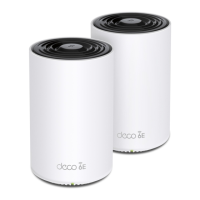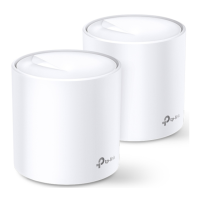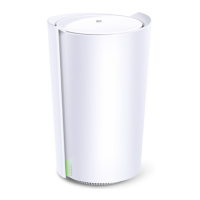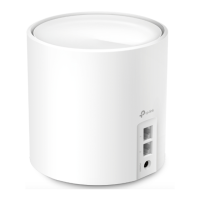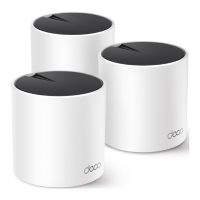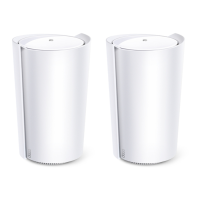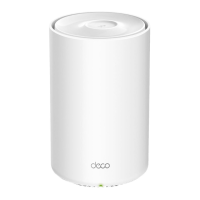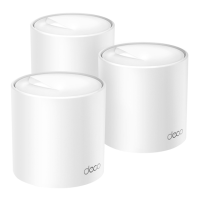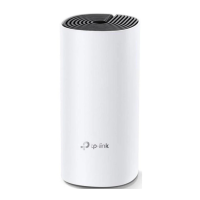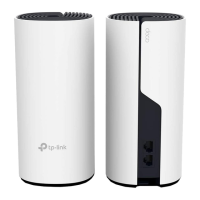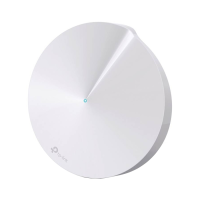Do you have a question about the TP-Link Deco XE75 Pro and is the answer not in the manual?
Defines conventions used in the guide for clarity and understanding.
Disclaimer on wireless performance, device capacity, and varying conditions.
Notes on MU-MIMO, IoT, and Seamless Roaming compatibility.
Explains HomeShield plans, features, and availability.
Explains the meaning of different LED colors and their status indications.
Describes the function of RJ-45 Ethernet ports and the power slot.
Details how to use the reset button for factory default settings.
Instructions for downloading and installing the mobile app.
Guides users on creating or logging into a TP-Link account.
Steps to select the correct Deco model during setup.
Steps to connect the Deco to the modem and power it on.
Assigns a physical location tag to the Deco unit.
Sets up the internet connection type and necessary details.
Establishes the Wi-Fi network name and password for devices.
Connects your phone/tablet to the new Deco Wi-Fi network.
Finalizes setup and provides options to add more Decos.
Checks network status, online devices, and speeds.
Guides on creating custom shortcuts and automated actions.
Enables access to enhanced security features and trials.
Accessing router settings and other advanced options.
Steps to add new Deco units to expand network coverage.
Choosing the specific Deco model to add to the system.
Checking the online/offline status of all Deco units.
Viewing speed, IP, MAC, and connected clients for each unit.
Monitoring the current internet speed performance.
Changing or customizing the location/name of a Deco unit.
Activating Mesh technology for seamless client switching.
Steps to start the process of replacing the main Deco.
Instructions for connecting the new main Deco to the modem.
Restarts a Deco unit to clear cache and improve performance.
Resets a Deco to factory settings, removing it from the network.
Checking real-time speeds, IP, MAC, and location of connected devices.
Renaming connected devices for easier identification.
Prioritizes device connection for a specified duration.
Setting up automated actions triggered by specific events.
Organizes devices into custom locations for easier management.
Allows users to create new location tags for devices.
Creates profiles for family members to manage device access.
Ensures smooth client transitions between Deco units.
Organizes devices based on their assigned location tags.
Accessing devices sorted by their custom locations.
Creates a new Deco network via the app's Overview page.
Creates a new Deco network via the app's main menu.
Steps to access the menu to create a new network.
Process of selecting and starting the creation of a new network.
Steps to begin the process of changing the network owner.
Process for confirming the new network owner's details.
Steps to find the delete option for a Deco network.
Process of confirming the deletion of the Deco network.
Steps to access the feature for adding smart devices.
Process of adding smart home devices to the Deco network.
Steps to start the creation of a new shortcut.
Selecting the type of action for a shortcut.
Choosing the specific device that the shortcut will control.
Defining how the action behaves when executed.
Setting the shortcut's icon and name for easy identification.
Tapping the shortcut icon to trigger the defined action.
Configuring when the automation rule becomes active.
Defining the event or condition that starts the automation.
Choosing the category of the trigger (e.g., lights, devices).
Choosing the specific device and condition for the trigger.
Defining the action to be performed by the automation.
Choosing the device that will execute the automation action.
Configuring action duration and any delay before execution.
Assigning a descriptive name to the automation rule.
Confirmation that the automation has been successfully set up.
Explains the purpose and benefits of the HomeShield service.
Guides on utilizing and upgrading HomeShield features.
Scans the network for potential risks and security improvements.
Provides protection against network attacks and threats.
Manages family members' internet access and online activities.
Prioritizes network traffic for specific devices.
Provides insights into network activity and protection history.
Changing network name, password, and hiding SSID.
Selecting channel width for improved 5GHz Wi-Fi performance.
Configuring the 6 GHz band for client Wi-Fi connections.
Changing network name and password for the 6 GHz band.
Creating a separate, isolated network for guests.
Customizing guest network name, password, and visibility.
Blocking specific devices from accessing the network.
Removing devices that were previously blacklisted.
Steps to find the firmware update feature in the app.
Process for updating Deco firmware for optimal performance.
Modifying internet connection types and IP settings.
Setting up firewall rules for IPv6 traffic.
Changing the LAN IP address to avoid conflicts.
Configuring the DHCP server for IP address assignment.
Supporting IPTV services with specific network modes.
Cloning MAC address to resolve internet connection issues.
Assigning static IP addresses to specific devices.
Allowing external access to local network devices.
Setting up dynamic DNS for remote access.
Facilitating SIP communication over NAT.
Allowing dynamic port opening for applications.
Ensuring seamless client switching between Decos.
Concentrating Wi-Fi signals for stronger connections.
Managing the behavior of the LED indicator light.
Switching between Router and Access Point modes.
Configuring alerts for device connection/disconnection events.
Selecting where and what types of alerts are received.
Steps to access the WPS feature in the Deco app.
Using WPS to quickly connect devices without a password.
Inviting friends or family to help manage the Deco network.
Process of adding a manager using their TP-Link ID email.
Defining the permissions and access levels for managers.
Removing previously added network managers.
Steps to integrate the Deco system with Amazon Alexa.
Controlling Deco features using voice commands via Alexa.
Solutions for issues finding the Deco during initial configuration.
Troubleshooting steps for devices failing to connect.
Solutions for sudden loss of internet connectivity.
Guidance on finding the best locations for Deco units.
Steps to resolve problems with the Deco mobile application.
Statement regarding compliance with FCC rules for digital devices.
Information on FCC RF exposure limits and compliance.
Notes on unauthorized modifications and user authority.
Details on mobile configuration RF exposure compliance.
Warning about potential radio interference in domestic environments.
Lists operating frequencies and maximum transmitted power.
Statement of compliance with EU directives.
EU RF exposure compliance for public exposure.
Usage limitations within EU member states and EFTA.
Information related to the UKCA mark and declaration.
Usage limitations for the device in Great Britain.
Compliance statement for Industry Canada license-exempt devices.
Caution regarding indoor use of the 5150-5250 MHz band.
Note on DFS products operating in specific frequency bands.
IC radiation exposure compliance for uncontrolled environments.
Warning about potential radio interference in Korea.
Advisories regarding frequency changes and interference.
Important safety advice for product usage and maintenance.
Information on restricted substances present in the product.
Details the presence of restricted substances in components.
General safety guidelines for operating the device safely.
Further safety guidelines and operating temperature details.
Explains the meaning of various symbols on the product label.
Guidance on responsible disposal and recycling of the product.
Warning about potential interference with medical devices.
Defines conventions used in the guide for clarity and understanding.
Disclaimer on wireless performance, device capacity, and varying conditions.
Notes on MU-MIMO, IoT, and Seamless Roaming compatibility.
Explains HomeShield plans, features, and availability.
Explains the meaning of different LED colors and their status indications.
Describes the function of RJ-45 Ethernet ports and the power slot.
Details how to use the reset button for factory default settings.
Instructions for downloading and installing the mobile app.
Guides users on creating or logging into a TP-Link account.
Steps to select the correct Deco model during setup.
Steps to connect the Deco to the modem and power it on.
Assigns a physical location tag to the Deco unit.
Sets up the internet connection type and necessary details.
Establishes the Wi-Fi network name and password for devices.
Connects your phone/tablet to the new Deco Wi-Fi network.
Finalizes setup and provides options to add more Decos.
Checks network status, online devices, and speeds.
Guides on creating custom shortcuts and automated actions.
Enables access to enhanced security features and trials.
Accessing router settings and other advanced options.
Steps to add new Deco units to expand network coverage.
Choosing the specific Deco model to add to the system.
Checking the online/offline status of all Deco units.
Viewing speed, IP, MAC, and connected clients for each unit.
Monitoring the current internet speed performance.
Changing or customizing the location/name of a Deco unit.
Activating Mesh technology for seamless client switching.
Steps to start the process of replacing the main Deco.
Instructions for connecting the new main Deco to the modem.
Restarts a Deco unit to clear cache and improve performance.
Resets a Deco to factory settings, removing it from the network.
Checking real-time speeds, IP, MAC, and location of connected devices.
Renaming connected devices for easier identification.
Prioritizes device connection for a specified duration.
Setting up automated actions triggered by specific events.
Organizes devices into custom locations for easier management.
Allows users to create new location tags for devices.
Creates profiles for family members to manage device access.
Ensures smooth client transitions between Deco units.
Organizes devices based on their assigned location tags.
Accessing devices sorted by their custom locations.
Creates a new Deco network via the app's Overview page.
Creates a new Deco network via the app's main menu.
Steps to access the menu to create a new network.
Process of selecting and starting the creation of a new network.
Steps to begin the process of changing the network owner.
Process for confirming the new network owner's details.
Steps to find the delete option for a Deco network.
Process of confirming the deletion of the Deco network.
Steps to access the feature for adding smart devices.
Process of adding smart home devices to the Deco network.
Steps to start the creation of a new shortcut.
Selecting the type of action for a shortcut.
Choosing the specific device that the shortcut will control.
Defining how the action behaves when executed.
Setting the shortcut's icon and name for easy identification.
Tapping the shortcut icon to trigger the defined action.
Configuring when the automation rule becomes active.
Defining the event or condition that starts the automation.
Choosing the category of the trigger (e.g., lights, devices).
Choosing the specific device and condition for the trigger.
Defining the action to be performed by the automation.
Choosing the device that will execute the automation action.
Configuring action duration and any delay before execution.
Assigning a descriptive name to the automation rule.
Confirmation that the automation has been successfully set up.
Explains the purpose and benefits of the HomeShield service.
Guides on utilizing and upgrading HomeShield features.
Scans the network for potential risks and security improvements.
Provides protection against network attacks and threats.
Manages family members' internet access and online activities.
Prioritizes network traffic for specific devices.
Provides insights into network activity and protection history.
Changing network name, password, and hiding SSID.
Selecting channel width for improved 5GHz Wi-Fi performance.
Configuring the 6 GHz band for client Wi-Fi connections.
Changing network name and password for the 6 GHz band.
Creating a separate, isolated network for guests.
Customizing guest network name, password, and visibility.
Blocking specific devices from accessing the network.
Removing devices that were previously blacklisted.
Steps to find the firmware update feature in the app.
Process for updating Deco firmware for optimal performance.
Modifying internet connection types and IP settings.
Setting up firewall rules for IPv6 traffic.
Changing the LAN IP address to avoid conflicts.
Configuring the DHCP server for IP address assignment.
Supporting IPTV services with specific network modes.
Cloning MAC address to resolve internet connection issues.
Assigning static IP addresses to specific devices.
Allowing external access to local network devices.
Setting up dynamic DNS for remote access.
Facilitating SIP communication over NAT.
Allowing dynamic port opening for applications.
Ensuring seamless client switching between Decos.
Concentrating Wi-Fi signals for stronger connections.
Managing the behavior of the LED indicator light.
Switching between Router and Access Point modes.
Configuring alerts for device connection/disconnection events.
Selecting where and what types of alerts are received.
Steps to access the WPS feature in the Deco app.
Using WPS to quickly connect devices without a password.
Inviting friends or family to help manage the Deco network.
Process of adding a manager using their TP-Link ID email.
Defining the permissions and access levels for managers.
Removing previously added network managers.
Steps to integrate the Deco system with Amazon Alexa.
Controlling Deco features using voice commands via Alexa.
Solutions for issues finding the Deco during initial configuration.
Troubleshooting steps for devices failing to connect.
Solutions for sudden loss of internet connectivity.
Guidance on finding the best locations for Deco units.
Steps to resolve problems with the Deco mobile application.
Statement regarding compliance with FCC rules for digital devices.
Information on FCC RF exposure limits and compliance.
Notes on unauthorized modifications and user authority.
Details on mobile configuration RF exposure compliance.
Warning about potential radio interference in domestic environments.
Lists operating frequencies and maximum transmitted power.
Statement of compliance with EU directives.
EU RF exposure compliance for public exposure.
Usage limitations within EU member states and EFTA.
Information related to the UKCA mark and declaration.
Usage limitations for the device in Great Britain.
Compliance statement for Industry Canada license-exempt devices.
Caution regarding indoor use of the 5150-5250 MHz band.
Note on DFS products operating in specific frequency bands.
IC radiation exposure compliance for uncontrolled environments.
Warning about potential radio interference in Korea.
Advisories regarding frequency changes and interference.
Important safety advice for product usage and maintenance.
Information on restricted substances present in the product.
Details the presence of restricted substances in components.
General safety guidelines for operating the device safely.
Further safety guidelines and operating temperature details.
Explains the meaning of various symbols on the product label.
Guidance on responsible disposal and recycling of the product.
Warning about potential interference with medical devices.
| AC adapter included | Yes |
|---|---|
| Number of products included | 1 pc(s) |
| Antenna type | Internal |
| Product type | Mesh router |
| Certification | CE, FCC, RoHS |
| Product color | White |
| Transmit power | FCC: \u003C30 dBm (2.4 GHz), \u003C30 dBm (5 GHz), \u003C30 dBm (6 GHz), CE: \u003C20 dBm (2.4 GHz), \u003C23 dBm (5 GHz), \u003C23 dBm (6 GHz) dBmW |
| Maximum coverage | 270 m² |
| Antennas quantity | 4 |
| Storage temperature (T-T) | -40 - 60 °C |
| Operating temperature (T-T) | 0 - 40 °C |
| Storage relative humidity (H-H) | 5 - 90 % |
| Operating relative humidity (H-H) | 10 - 90 % |
| Ethernet LAN (RJ-45) ports | 3 |
| Firewall security | SPI Firewall |
| Processor frequency | 1.7 GHz |
| Number of guest networks (5 GHz) | 1 |
| Wi-Fi band | Tri-band (2.4 GHz / 5 GHz / 6 GHz) |
| Apps supported | TP-Link Deco |
| Wi-Fi standards | 802.11a, 802.11b, 802.11g, Wi-Fi 4 (802.11n), Wi-Fi 5 (802.11ac), Wi-Fi 6 (802.11ax), Wi-Fi 6E (802.11ax) |
| Top Wi-Fi standard | Wi-Fi 6E (802.11ax) |
| Security algorithms | WPA, WPA2-PSK, WPA3 |
| Networking standards | IEEE 802.11a, IEEE 802.11ac, IEEE 802.11ax, IEEE 802.11b, IEEE 802.11g, IEEE 802.11n |
| WLAN data transfer rate (first band) | 574 Mbit/s |
| WLAN data transfer rate (second band) | 2402 Mbit/s |
| AC adapter frequency | 50 - 60 Hz |
| AC adapter input voltage | 100 - 240 V |
| AC adapter output voltage | 12 V |
| Width | 105 mm |
|---|---|
| Height | 169 mm |
